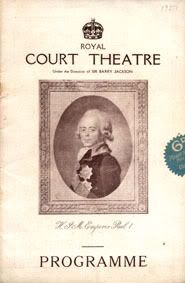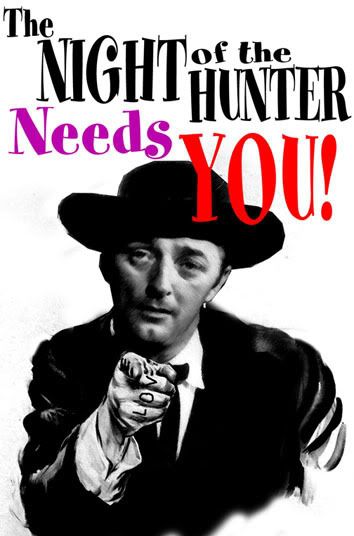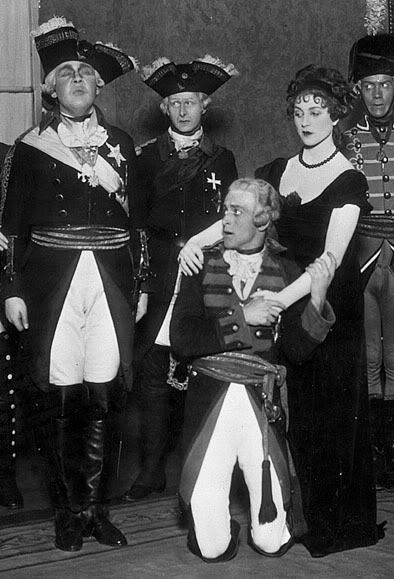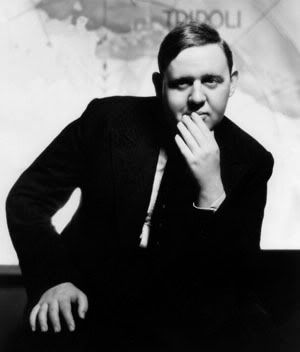Update: a new text was added to this post in September 15th, 2006
I recently got this photograph, which has possibly spent ages in the depths of an archive vault, among other ignored treasures. This something more than a mere picture from an old play, it captures...
...A turning point 
London, October 1927. The actors appear in "Paul I" a play by Dimitri Merejkowsky about the life the Mad Czar, son of Catherine the Great. George Hayes played the title role. The young man in the three-cornered hat who stands in the middle of the scene is Charles Laughton, whom
Komisarjevsky has been rearing since he spotted the flair of his 26-year old student at RADA. Komisarjevsky was an intelligent director who valued talent above looks, and also regarded highly actors with imagination and creativity. He knew the potential of his protegé.
The character played by Laughton is Count Pahlen, one of the conspirators against the emperor, defined as Machiavelian by one reviewer. James Agate, who praised his performance, said that in his work "
(...) there was suggestion of enough intellectual vigour to go round a dozen plays" which well describes Laughton's prodigal way of acting: he would never treat as unimportant a secondary character, he would make a living being even out the most humble of stage spear-carriers. Where others would assume a perfunctory attitude, Laughton went full speed ahead.
Front, from left to right: Laughton, Carl Harbord, Lydia SherwoodSo far he has been in secondary roles, from early short appearances, as those in the Russian plays staged at Barnes Theatre in 1926, to character roles capable of outshadowing a lead as in "Liliom". Pahlen will be the last of a row of secondary roles with which the young actor has awed public and critics: in his next play, "Mr. Prohack" he will play a lead. He would continue to play leads from then onwards for most of his life. For someone whose looks were not those of a matinée idol it was, and remains, a feat.
In the cast of "Mr. Prohack" he met Elsa Lanchester, who played the short role as Prohack's secretary. In a way, "Paul I" is the last stage before the beginning of his "public life": in biographies, and due to the fact that the main source about Laughton's life was his widow, his life and career up to "Mr. Prohack" is not as well recorded as one would like to, in fact, Charles (whether young or old) remains elusive, and what we know about his life is ultimately as seen (juggled?) through Lanchester's looking glass.
The shape of the things to come?The knowledgeable Laughtonian May find in the photo something familiar: Doesn't Charles' Pahlen remind you of Bligh and Javert?
The Cast: In the photo, I can only identify Laughton and, from other pictures of the production Carl Harbord and Lydia Sherwood... Maybe anyone could help in identifying the rest of the actors in the scene? The cast was as follows:
Grand Duke Alexander: Carl Harbord
Elizabeth, his wife: Lydia Sherwood
Paul I, Emperor of Russia: George Hayes
Grand Duke Constantin: Elliott Seabrooke
Lieutenant Marin: Arthur Macrae
General Count Pahlen, Governor of Petersburg: Charles Laughton
General Talyzin: Hugh Barnes
Colonel Prince Yashvil: Bramwell Fletcher
General Bennigsen: Vivian Beymon
Coronel Argamakov: Ian Davison
Doctor Rodgerson: Dan F. Roe
Empress Marie: Dorothy Green
Princess Anna Gagarine, Lady-in-waiting to the Empress: Dorothy Cheston
Colonel Baron Rosen: Dan F. Roe
Lieutenant Bibikov: W.E.C. Jenkins
Cornet Gardanov: G. Vernon
Prince Platon Zoubov: Scott Sunderland
Prince Nicolas Zoubov: Barry K. Barnes
Guards of the emperor: Kirilov: W.E.C. Jenkins
Ropchinsky: Arthur Macrae
Direction of the Play and settings designed by Theodore Komisarjevsky
An curious caption This is from the text behind the still:
This shows Laughton years ago in "The Patriot" which later served as a film vehicle for Emil Jannings with whom Laughton is constantly compared
This caption is partly inaccurate.
Emil Jannings played the part of the Czar, while Laughton had been Count Pahlen (the role which in the film was played by Lewis Stone).
"The Patriot" (1928) was directed by
Ernst_Lubitsch and the script, albeit based in Merejovski's play, had been modified by three subsequent hands: so "The Patriot" was not exactly "Paul I".
As mentioned in the caption, when Laughton reached Hollywood in 1932, he was greeted by some as "The new Jannings". Jannings, who had preceded Laughton in Hollywood as a star character actor, left America with the advent of talkies, as his strong German accent was deemed not suitable for sound pictures. Laughton, though, would soon prove to be more than a mere English-speaking substitute of the great German actor.
"The Patriot" seems to be lost except from a few extant reels. I think it's sad that a film by Lubistch -and with Jannings!- is lost while cellulloid items such as "Plan 9 from outer space" are perfectly preserved and have special DVD edition
Acknowledgements: I wouldn't have been able to tell the story behind the photograph without being properly sourced, so I must thank the
Mander and Mitchenson Theatre Collection for kindly providing me with the required reference.















